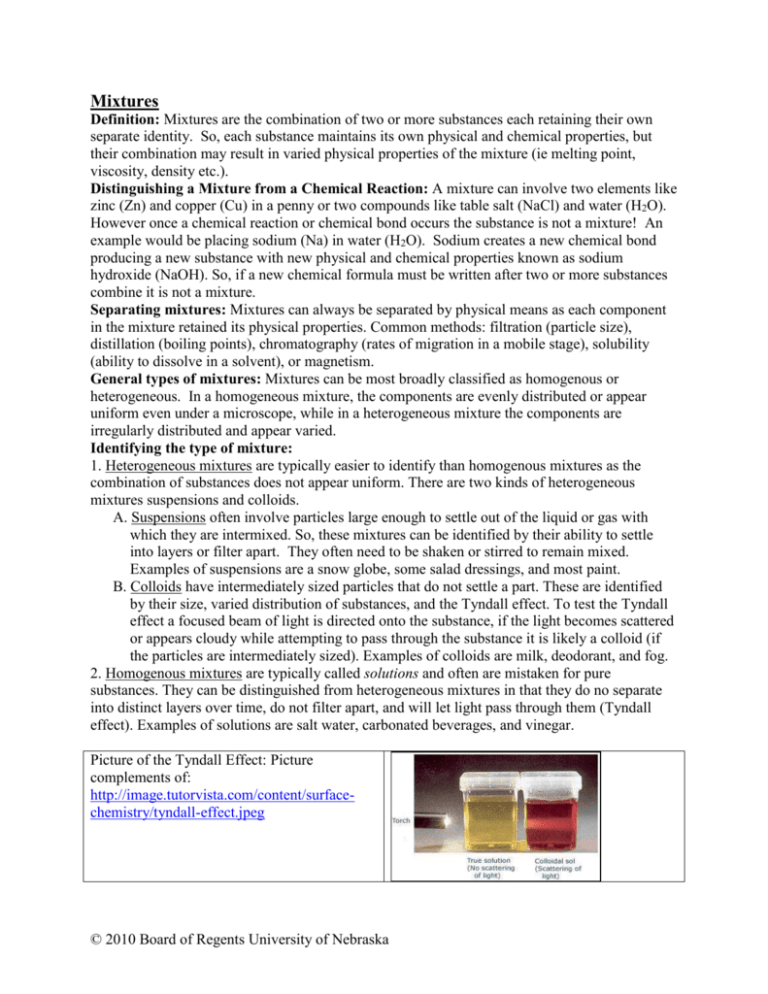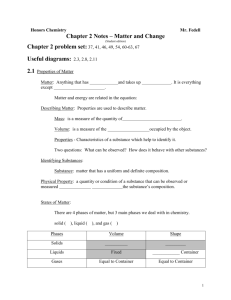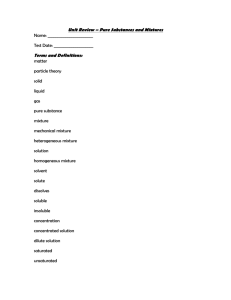Mixtures
advertisement

Mixtures Definition: Mixtures are the combination of two or more substances each retaining their own separate identity. So, each substance maintains its own physical and chemical properties, but their combination may result in varied physical properties of the mixture (ie melting point, viscosity, density etc.). Distinguishing a Mixture from a Chemical Reaction: A mixture can involve two elements like zinc (Zn) and copper (Cu) in a penny or two compounds like table salt (NaCl) and water (H2O). However once a chemical reaction or chemical bond occurs the substance is not a mixture! An example would be placing sodium (Na) in water (H2O). Sodium creates a new chemical bond producing a new substance with new physical and chemical properties known as sodium hydroxide (NaOH). So, if a new chemical formula must be written after two or more substances combine it is not a mixture. Separating mixtures: Mixtures can always be separated by physical means as each component in the mixture retained its physical properties. Common methods: filtration (particle size), distillation (boiling points), chromatography (rates of migration in a mobile stage), solubility (ability to dissolve in a solvent), or magnetism. General types of mixtures: Mixtures can be most broadly classified as homogenous or heterogeneous. In a homogeneous mixture, the components are evenly distributed or appear uniform even under a microscope, while in a heterogeneous mixture the components are irregularly distributed and appear varied. Identifying the type of mixture: 1. Heterogeneous mixtures are typically easier to identify than homogenous mixtures as the combination of substances does not appear uniform. There are two kinds of heterogeneous mixtures suspensions and colloids. A. Suspensions often involve particles large enough to settle out of the liquid or gas with which they are intermixed. So, these mixtures can be identified by their ability to settle into layers or filter apart. They often need to be shaken or stirred to remain mixed. Examples of suspensions are a snow globe, some salad dressings, and most paint. B. Colloids have intermediately sized particles that do not settle a part. These are identified by their size, varied distribution of substances, and the Tyndall effect. To test the Tyndall effect a focused beam of light is directed onto the substance, if the light becomes scattered or appears cloudy while attempting to pass through the substance it is likely a colloid (if the particles are intermediately sized). Examples of colloids are milk, deodorant, and fog. 2. Homogenous mixtures are typically called solutions and often are mistaken for pure substances. They can be distinguished from heterogeneous mixtures in that they do no separate into distinct layers over time, do not filter apart, and will let light pass through them (Tyndall effect). Examples of solutions are salt water, carbonated beverages, and vinegar. Picture of the Tyndall Effect: Picture complements of: http://image.tutorvista.com/content/surfacechemistry/tyndall-effect.jpeg © 2010 Board of Regents University of Nebraska









